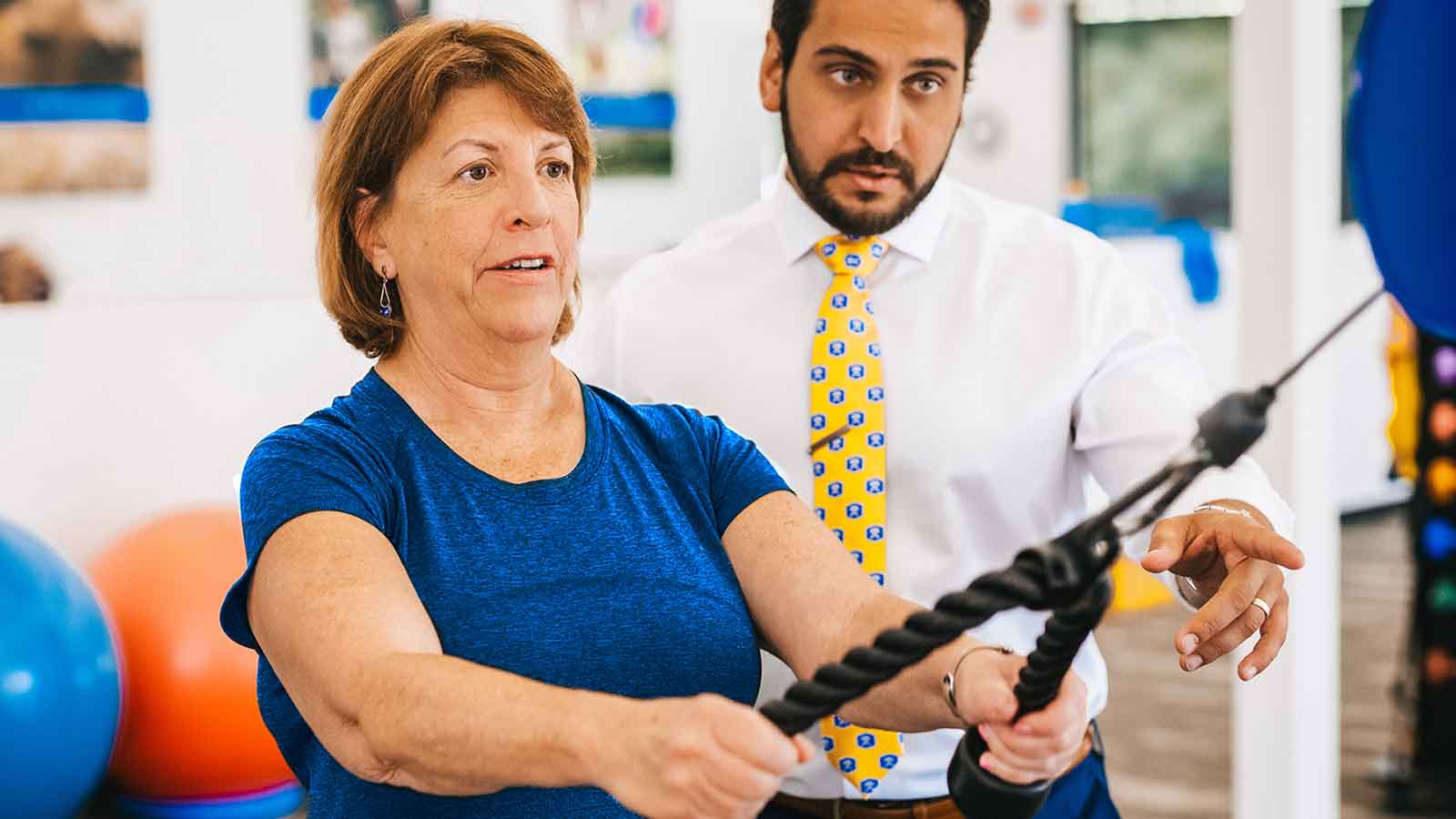5 Exercises for Shoulder Pain

The shoulder is one of the most flexible joints in the human body. It allows people to use their arms for a wide range of functional activities and is therefore critical to daily life.
A PT Solutions therapist can help you manage shoulder pain and gain back mobility in your arms. Below are five exercises our therapists may recommend to help reduce shoulder pain.
Shoulder Pain Physical Therapy Exercises
1. Overhead Press Exercise
This exercise is one of the most essential for developing shoulder strength and increasing mobility. It may be painful at first, but you can modify the movement in several ways.
- Start by standing and use a light weight in one or both hands.
- Bring the weight to shoulder height with your elbow fully bent. You should be able to hold the weight here comfortably.
- Press the weight overhead until your arms lock out.
- Control the movement back down to the starting position with your elbows fully bent.
2. Row Exercise
The rotator cuff muscles are essential for shoulder health. They help you rotate and elevate your arm. Contrary to popular belief, you don’t need banded shoulder rotation exercises to strengthen your rotator cuff. Rows are one of the best ways to build rotator cuff and general shoulder strength. You can vary the row by changing the starting position to perform high, mid, or low rows.
- You will need a cable column, bands, or free weights for this exercise.
- The bands and cable column are used for high, mid, and low rows. The free weights and bands are used for bent-over rows.
- For low, mid, and high rows, start in a standing or sitting position. The cable or band should be anchored above your head (high row), abdomen to chest high (mid row), or knee level (low row). Pull the cable or bands towards you, pitching your shoulder blades together until your elbows pass your back. Stand far enough back, so your arms are fully extended at the starting and end positions.
- For bent-over rows, make the same pulling motion, but bend your hips, so your chest is over your toes. Pull the weights up like the other rows.
3. Lat Pulldown Exercise
Latissimus pulldown or lat pulldowns and pull-up exercises are two of the best ways to develop your latissimus dorsi, the large “v-shaped” muscles on your back. They are the primary muscles for pulling your arm down and rotating it internally.
- For this exercise, you need either a pull-up bar, a lat pulldown machine, or a band secured to the top of a door or ceiling anchor.
- Grab the bar or band in a standing or sitting position.
- Pull the bar or band down until they reach neck level.
- Slowly return to the starting position.
4. Trunk Rotation Exercise
To effectively reach forward and overhead, we need to be able to rotate and extend our mid-back, known as the thoracic spine. We can use trunk rotations to improve the strength, mobility, and endurance of the muscles surrounding our thoracic spine.
- You can start by doing this exercise without weight, either lying on your side, sitting, or standing. One your side, reach your top hand as far forward as possible. Then pull that arm up towards the ceiling and reach behind yourself, trying to touch the floor, causing your spine to rotate.
- To build strength and endurance, perform the trunk rotations in sitting or standing with a band or cable column.
- Face perpendicular to the cable column or band attachment
- Rotate your body and grab the band or cable handle with your arms straight
- Rotate 180 degrees to face away from the cable or band while trying to keep your arms straight.
- Slowly return to the starting position.
5. Farmer’s Carry Exercise
Carrying objects helps us develop grip and shoulder strength. The trapezius and levator scapulae are the primary muscles you will develop in the shoulder with farmer’s carry and shrug exercises. Those muscles are key for raising our arms above our head.
- Pick up a weight or heavy object in each or both hands (can alternate hands each set).
- Walk with the weight until you feel a few seconds from dropping the weight.
- You can vary the difficulty by maintaining a shrug while walking (bring your shoulders towards your ear) or by holding the weight directly overhead with a straight or bent elbow.
Physical therapy strengthens the shoulder and surrounding muscles. Strengthening all shoulder related muscles can help to counteract the damaged areas and improve the range of motion of the shoulder joint.
Physical therapy may be an effective treatment for shoulder pain. At PT Solutions, we provide patients with customized treatment plans that include exercises designed to improve the strength of the shoulder muscles. Our physical therapists will work with you to help you retrain these muscles and get you back to the activities you enjoy.
Find a Location
Find a PT Solutions clinic near you.
The PT Solutions Difference
Evidence-based – Our physical therapy treatments are always grounded in scientific research to deliver effective, cutting-edge care.
Dedicated – We’re dedicated to helping you reach your goals, always providing guidance on how to live a pain-free life beyond treatment.
Encouraging – You’ll have our team’s support and motivation throughout your journey to wellness.